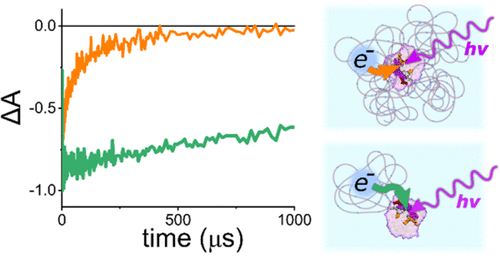当前位置:
X-MOL 学术
›
J. Phys. Chem. B
›
论文详情
Our official English website, www.x-mol.net, welcomes your
feedback! (Note: you will need to create a separate account there.)
Insight into Electron Transfer from a Redox Polymer to a Photoactive Protein
The Journal of Physical Chemistry B ( IF 2.8 ) Pub Date : 2020-11-25 , DOI: 10.1021/acs.jpcb.0c08714 Rafał Białek 1 , Kalyani Thakur 2 , Adrian Ruff 3 , Michael R Jones 4 , Wolfgang Schuhmann 3 , Charusheela Ramanan 2 , Krzysztof Gibasiewicz 1
The Journal of Physical Chemistry B ( IF 2.8 ) Pub Date : 2020-11-25 , DOI: 10.1021/acs.jpcb.0c08714 Rafał Białek 1 , Kalyani Thakur 2 , Adrian Ruff 3 , Michael R Jones 4 , Wolfgang Schuhmann 3 , Charusheela Ramanan 2 , Krzysztof Gibasiewicz 1
Affiliation

|
Biohybrid photoelectrochemical systems in photovoltaic or biosensor applications have gained considerable attention in recent years. While the photoactive proteins engaged in such systems usually maintain an internal charge separation quantum yield of nearly 100%, the subsequent steps of electron and hole transfer beyond the protein often limit the overall system efficiency and their kinetics remain largely uncharacterized. To reveal the dynamics of one of such charge-transfer reactions, we report on the reduction of Rhodobacter sphaeroides reaction centers (RCs) by Os-complex-modified redox polymers (P-Os) characterized using transient absorption spectroscopy. RCs and P-Os were mixed in buffered solution in different molar ratios in the presence of a water-soluble quinone as an electron acceptor. Electron transfer from P-Os to the photoexcited RCs could be described by a three-exponential function, the fastest lifetime of which was on the order of a few microseconds, which is a few orders of magnitude faster than the internal charge recombination of RCs with fully separated charge. This was similar to the lifetime for the reduction of RCs by their natural electron donor, cytochrome c2. The rate of electron donation increased with increasing ratio of polymer to protein concentrations. It is proposed that P-Os and RCs engage in electrostatic interactions to form complexes, the sizes of which depend on the polymer-to-protein ratio. Our findings throw light on the processes within hydrogel-based biophotovoltaic devices and will inform the future design of materials optimally suited for this application.
中文翻译:

深入了解从氧化还原聚合物到光活性蛋白质的电子转移
近年来,光伏或生物传感器应用中的生物混合光电化学系统引起了相当大的关注。虽然参与此类系统的光活性蛋白质通常保持接近 100% 的内部电荷分离量子产率,但随后的电子和空穴转移到蛋白质之外的步骤通常会限制整个系统的效率,并且其动力学在很大程度上仍未得到表征。为了揭示其中一种电荷转移反应的动力学,我们报告了使用瞬态吸收光谱表征的 Os 复合物修饰的氧化还原聚合物 (P-Os) 还原球形红杆菌反应中心 (RC) 的情况。在水溶性醌作为电子受体的情况下,将 RC 和 P-O 在缓冲溶液中以不同的摩尔比混合。从 P-Os 到光激发 RC 的电子转移可以用三指数函数来描述,其最快寿命约为几微秒,这比 RC 的内部电荷复合快几个数量级。完全分离的电荷。这与 RC 被其天然电子供体细胞色素c 2还原的寿命相似。电子供给率随着聚合物与蛋白质浓度之比的增加而增加。有人提出,P-O 和 RC 通过静电相互作用形成复合物,其大小取决于聚合物与蛋白质的比例。我们的研究结果揭示了基于水凝胶的生物光伏器件的过程,并将为未来设计最适合该应用的材料提供信息。
更新日期:2020-12-10
中文翻译:

深入了解从氧化还原聚合物到光活性蛋白质的电子转移
近年来,光伏或生物传感器应用中的生物混合光电化学系统引起了相当大的关注。虽然参与此类系统的光活性蛋白质通常保持接近 100% 的内部电荷分离量子产率,但随后的电子和空穴转移到蛋白质之外的步骤通常会限制整个系统的效率,并且其动力学在很大程度上仍未得到表征。为了揭示其中一种电荷转移反应的动力学,我们报告了使用瞬态吸收光谱表征的 Os 复合物修饰的氧化还原聚合物 (P-Os) 还原球形红杆菌反应中心 (RC) 的情况。在水溶性醌作为电子受体的情况下,将 RC 和 P-O 在缓冲溶液中以不同的摩尔比混合。从 P-Os 到光激发 RC 的电子转移可以用三指数函数来描述,其最快寿命约为几微秒,这比 RC 的内部电荷复合快几个数量级。完全分离的电荷。这与 RC 被其天然电子供体细胞色素c 2还原的寿命相似。电子供给率随着聚合物与蛋白质浓度之比的增加而增加。有人提出,P-O 和 RC 通过静电相互作用形成复合物,其大小取决于聚合物与蛋白质的比例。我们的研究结果揭示了基于水凝胶的生物光伏器件的过程,并将为未来设计最适合该应用的材料提供信息。











































 京公网安备 11010802027423号
京公网安备 11010802027423号